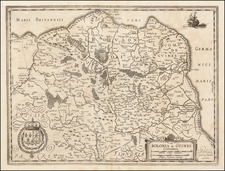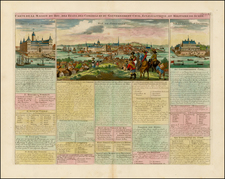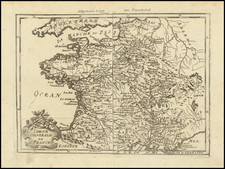Napoleon III's Military Showpiece
Fine depiction of Napoleon III prized military camp, with significant annotations showing the military maneuvers in the Summer of 1866.
The present example is filled with annotations in different colors, illustrating the primary encampments of the Cavalry (red), 1st Division (yellow) and 2nd Division (blue), the position taken up by the 2nd Division on July 23, 1866, locations of batteries and a number of other annotations.
Camp de Châlons
Camp de Châlons, also known as camp de Mourmelon, is a military camp of about 10,000 hectares at Mourmelon-le-Grand, near Châlons-en-Champagne. It was created under the authority of Napoleon III and opened August 30, 1857 during the Second French Empire.
The initial purpose was simply for practicing military manoeuvers, but would become a showcase of the French Imperial Army, a theatrical propaganda display, where French citizens could meet the army and watch parades. Each year the camp was transformed into a town of tents and wooden chalets.
The camp survived the fall of the Second Empire in 1872, but changed into a training camp and a departure point for troops engaging in overseas operations.
The Summer of 1866
The summer of 1866 was a particularly well documented year for Camp de Châlons. This was the year that Napoleon commissioned photographers Gustave Le Gray and M. Masson to produce a photo album he offered to the officers present and the year the French artist Eugène Bellangé painted the famed work Le camp de Châlons en 1866, depicting daily life in the encampment devoted to preparations for the feast of the Emperor, Saint-Napoleon, traditionally held on August 15th.
Rarity
The Plan is very rare. We have been unable to locate another example of the map.
We note a map with a similar title published by the Depot de La Guerre in 1865 and held by the National Library of France and 2 other European libraries, which notes that it was created by Cap.ne d'Etat-Major Celis and engraved by Erhard. As these notes are not present on our map, it would seem to be a different map.















![(Napoleon III) Camp De Chalons - Sur - Marne / Plan du Terrain Affecte au Camp et Des Terrains Environnans Leve par les Officieres du Genie Paris 1857 [with military movements added by hand]](https://storage.googleapis.com/raremaps/img/small/65093op.jpg)
![[Paris - Soissons - Champagne / area between the Seine River, Oise, River, Aisne River and Marne Rivers]](https://storage.googleapis.com/raremaps/img/small/90932.jpg)